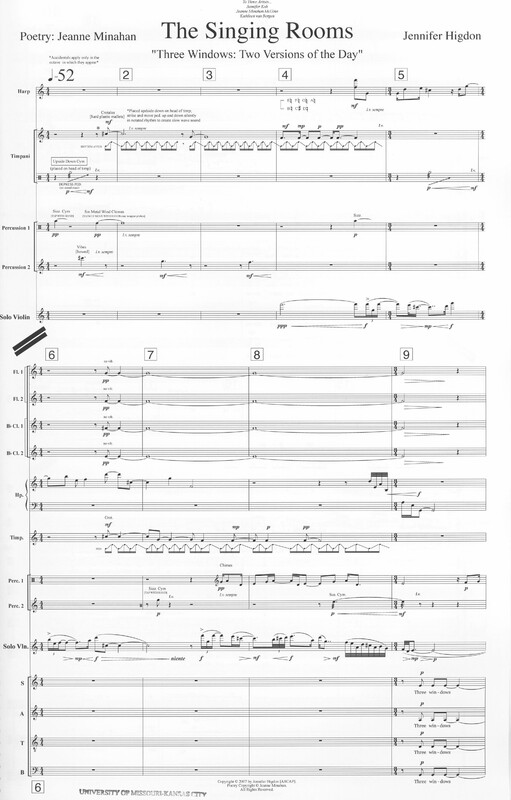The Singing Rooms
Item
-
Score title
-
The Singing Rooms
-
Composer
-
Jennifer Higdon
-
Program note
-
This is a house where the violin sings, the choir sings, and the orchestra sings. Every room is its own sound world. Not an ordinary house, this is the house that we all inhabit: that of life. The beauty of poetry and music is that each person brings their own experience to these art forms, and each reader takes away the message of the poet, mixed with their own story…but we all share these stories…
Three Windows: Two Versions of the Day
Set twice within this piece (at the beginning and at the end), the first musical setting is the emergence of the day, at its very early crescent of light…a more spare entry into this house of “The Singing Rooms”. It is the image and sound of “…cool and sweet, a blue cascade of watered light…”.
Things Aren’t Always
Always shifting, moving…not all things are what they seem.
The Interpretation of Dreams
As life sometimes moves in dreamlike fashion, I decided to set this with a gentle sort of “boat rocking” sensation (the poet refers to a dream on a boat). I also decided that I would set this poem three times, because of its brevity, and because of its position as the third poem in this set.
Confession
The fragility of handing over a confession to another is sometimes anxiety producing. This anxiety is mirrored in the opening of this movement, but calms at the moment that the choir unfolds with the opening stanza referring to the dream of sleeping within a flower (which I pictured as opening and expanding). An interesting note, Pleiades is mentioned in the 3rd stanza…its meaning: an open star cluster in the constellation Taurus, which consists of several hundred stars, with only 6 visible to the human eye. I found this particular tidbit fascinating mostly because, before reading the definition, I had written a 6-note figure for the violin that occurs repeatedly within this movement, in different guises. I confess that sometimes I don’t know where the music comes from, but I’m often startled by its appropriateness to the moment of putting note to page.
History Lesson
Falling gestures…rising gestures….the difference between (as the poet says) the “…brief pause between despair and comfort…”. Of all the movements, this is the shortest…a mere 3 minutes. Why? It was an intentional decision to reflect on how we seem to remember the lessons of history for such short amounts of time.
A Word with God
For a composer, it is intimidating to think of how one sets into music such a thing as speaking to God. Certainly many other composers have done so throughout history. But I loved the idea of starting it as an intimate conversation, so I wrote a duet between the English Horn and the Solo Violin, which eventually evolves into a series of emotions and conversations, adding voices and varying degrees of urgency.
Jeanne Minahan opens this poem with an Irish Proverb: “Your feet will bring you to where your heart is”. I chose to place this wonderful proverb at the end of this movement, because after the poem, “A Word with God”, I wanted to carry the listener back to the original room of three windows, now with a new view of the day…at its end….and inevitably, your feet will bring you to where your heart is.
Three Windows: Two Versions of the Day
The 2nd setting of this poem presents the second version of the day: a view at the close of a day in life…a return to the original room, but with wisdom gained and all seen in a new light.
The Singing Rooms was commissioned by The Philadelphia Orchestra, The Atlanta Symphony Orchestra, and the Minnesota Orchestra.
 Jennifer Higdon
Jennifer Higdon

